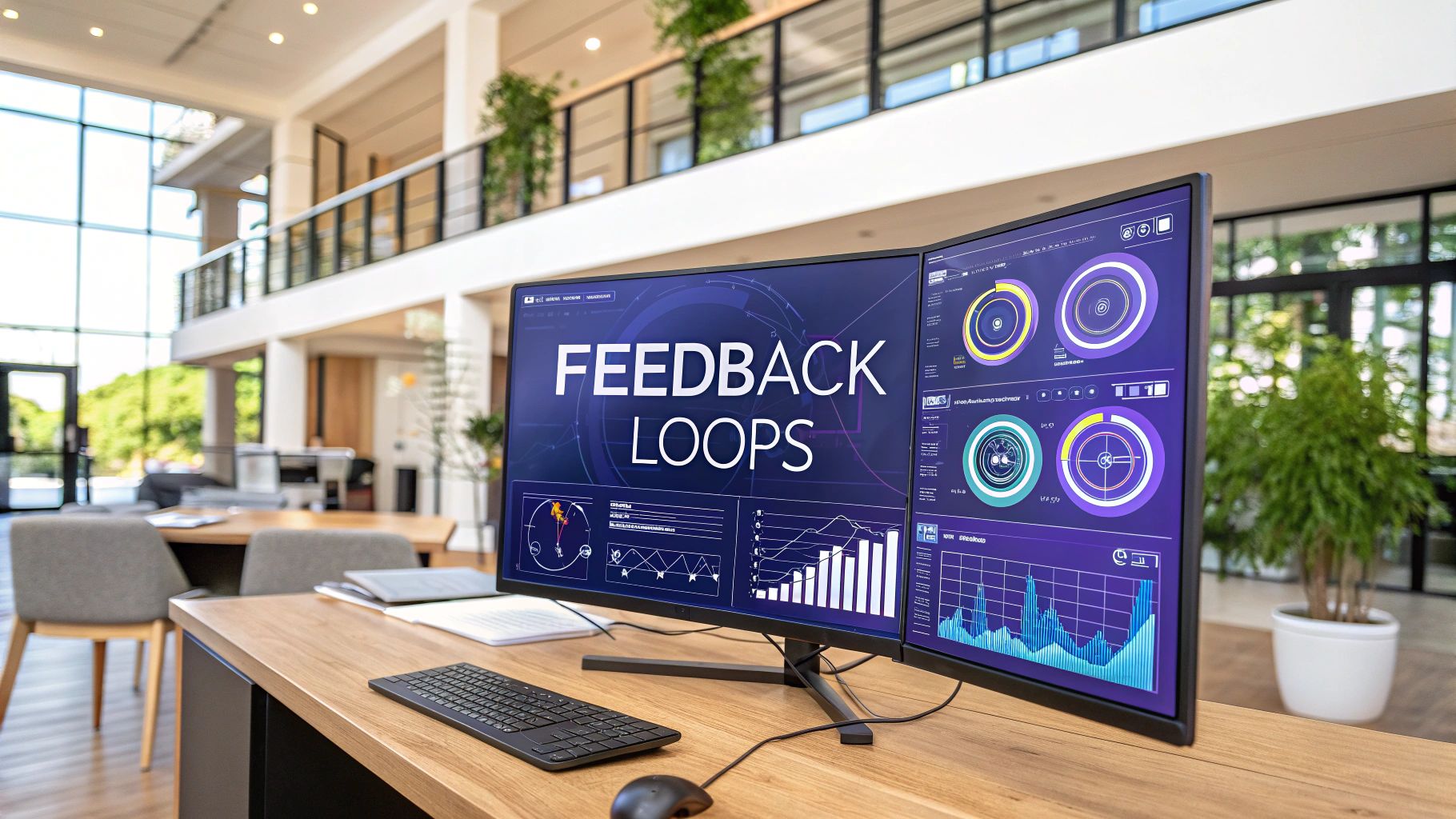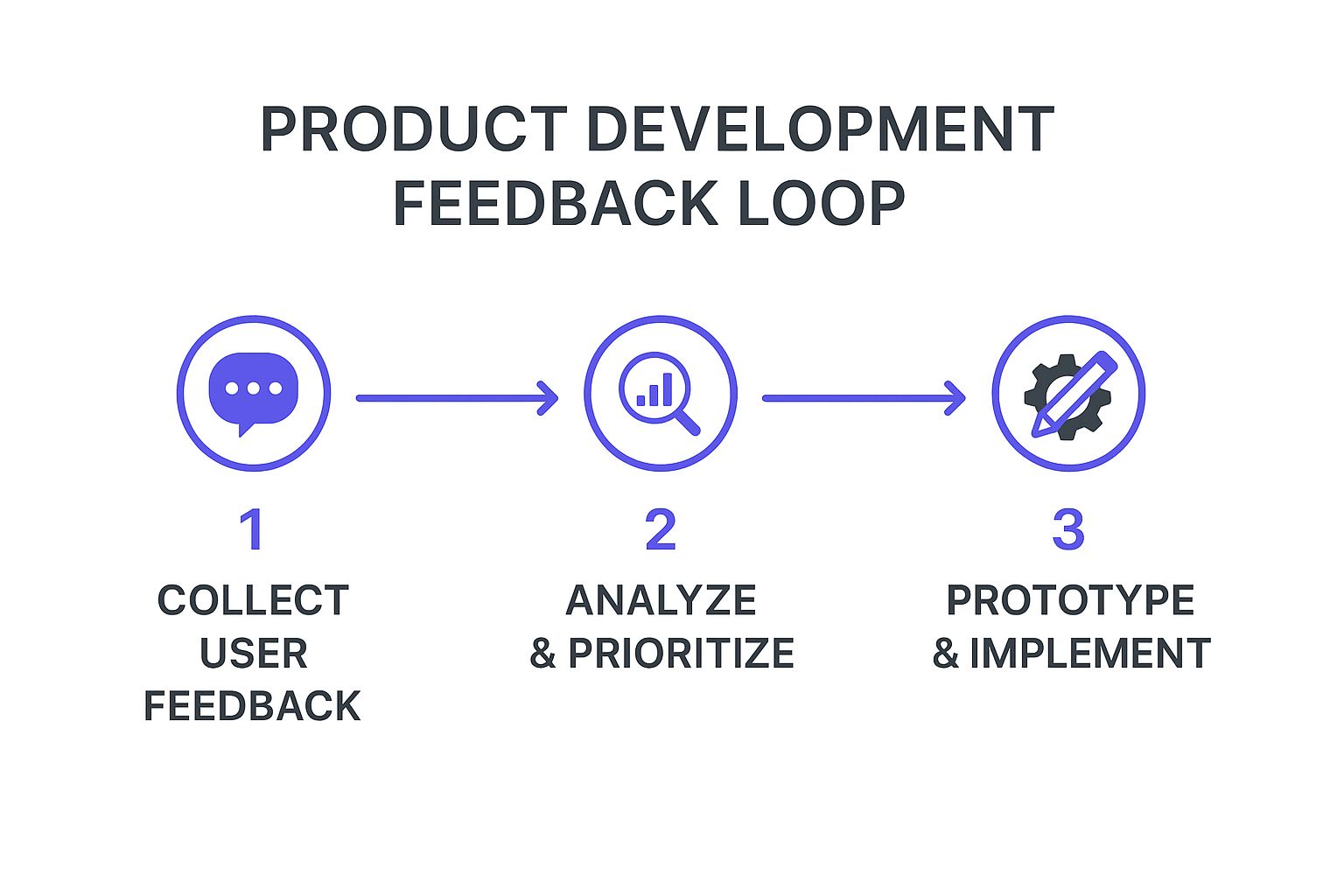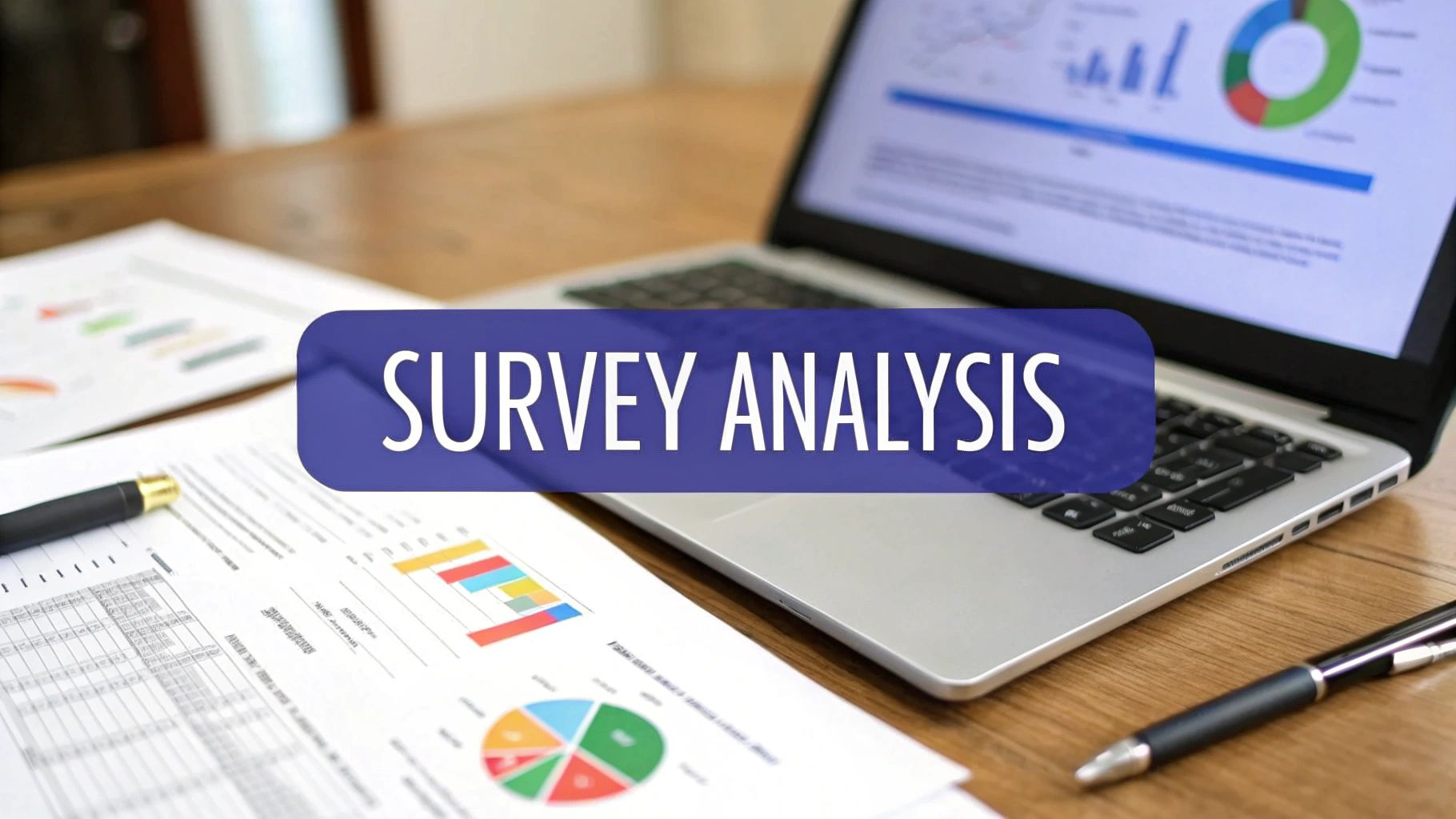8 Powerful Feedback Loop Examples for SaaS Growth in 2025
Discover 8 actionable feedback loop examples from leading companies. Learn how to turn insights into growth and improve your SaaS product and customer service.

In the competitive SaaS landscape, understanding your user is no longer a 'nice-to-have'—it's the core driver of growth, retention, and innovation. The most successful companies don't just listen; they build intelligent, self-improving systems known as feedback loops. These loops are the engines that turn raw user sentiment into product breakthroughs, sticky features, and sustainable revenue. But what separates a basic suggestion box from a high-performance growth engine? The difference lies in deliberate design and execution.
A well-structured feedback loop is a continuous cycle: collecting insights, analyzing them to find the signal in the noise, acting on those findings, and then closing the loop by communicating changes back to users. This final step is crucial as it encourages more high-quality feedback. This cycle transforms passive listening into an active, strategic advantage.
This article moves beyond theory to provide a strategic breakdown of 8 powerful feedback loop examples. We'll dissect how industry leaders across SaaS and adjacent sectors use these systems not just to fix problems, but to predict user needs, drive engagement, and build products that feel indispensable. You will get a behind-the-scenes look at the specific tactics and actionable takeaways you can apply to your own business. We will explore how tools can automate and streamline this process, enabling teams to create these powerful growth cycles with greater efficiency and impact. Get ready to transform your approach from passive data collection to active, strategic growth.
1. The Product Development Feedback Loop: Spotify’s Iterative Genius
At its core, the Product Development Feedback Loop is the engine of agile and user-centric innovation. It's a systematic process where companies collect user feedback on their products, analyze it to identify patterns and priorities, implement improvements, and then gather more feedback on the changes. This continuous cycle helps refine products based on actual user needs and preferences, drastically reducing the risk of building features no one wants.
Spotify's evolution from a simple music player to a personalized audio universe is a masterclass in this loop. They continuously gather data on listening habits, playlist creation, and feature usage to inform everything from their algorithm-driven 'Discover Weekly' playlists to UI adjustments. This ensures the product doesn't just meet user expectations; it anticipates them.

Strategic Analysis: How Spotify Masters the Loop
Spotify's strategy isn't just about collecting data; it's about translating that data into a deeply personal user experience. This is one of the most powerful feedback loop examples because it demonstrates a proactive, not reactive, approach.
- Data Collection: Spotify gathers billions of data points daily, from song skips and replays to the time of day users listen to specific genres. They also use direct feedback channels like A/B tests on new features and user surveys.
- Insight Generation: Analysts and machine learning models sift through this data to identify micro-trends. A key insight was that users who created playlists were more engaged and less likely to churn. This led to a major focus on making playlist creation and discovery frictionless.
- Actionable Implementation: This insight directly birthed features like "Discover Weekly" and "Release Radar." These algorithmically-generated playlists weren't just a cool feature; they were a direct, data-driven solution to enhance user engagement and retention, making the product stickier. The entire process is a foundational part of their product development lifecycle. To learn more about how to structure these insights, see our guide on how to create a product roadmap.
Actionable Takeaways for Your Business
You don't need Spotify's budget to implement a powerful product development feedback loop. The principles are scalable to any SaaS business.
- Integrate Quantitative and Qualitative Data: Combine hard data (like feature usage metrics) with qualitative feedback (from support tickets or user interviews). This provides a complete picture of not just what users are doing, but why.
- Prioritize ruthlessly: Use feedback to inform your product roadmap. Focus on changes that will impact the most users or solve the most critical pain points identified in your data.
- Close the Loop: When you release a feature based on feedback, communicate it to your users. This shows them you are listening and encourages them to provide more valuable insights in the future.
For teams implementing agile methodologies, leveraging resources like agile retrospective templates can significantly enhance the feedback collection and action planning process. This approach formalizes the "reflection" stage of the loop, ensuring insights are captured and acted upon consistently.
2. The Employee Performance Feedback Loop: Fueling Organizational Growth
The Employee Performance Feedback Loop is a dynamic system for cultivating talent and aligning individual efforts with company goals. It moves beyond the outdated annual review, creating a continuous cycle of goal setting, performance dialogue, coaching, and recognition. This approach fosters a culture of transparency and continuous improvement, where feedback is a tool for development, not just evaluation.
Companies like Google and Adobe have famously pioneered this shift. Google's OKR (Objectives and Key Results) system creates a clear, ambitious framework, while Adobe's "Check-In" process replaced formal reviews with ongoing, less formal conversations. These systems transform performance management from a top-down mandate into a collaborative partnership, directly linking individual growth to business outcomes.
Strategic Analysis: How High-Performing Companies Master the Loop
The success of modern performance management lies in making feedback a constant, two-way street. It's one of the most crucial internal feedback loop examples because it directly impacts a company's most valuable asset: its people. The goal is to build a culture where constructive dialogue is expected and welcomed.
- Data Collection: Instead of waiting a year, managers and peers provide regular, timely feedback. This can be through formal check-ins, peer review software, or informal conversations. Netflix famously uses its "keeper test" and a culture of radical candor to gather continuous performance data.
- Insight Generation: This constant stream of information provides a real-time picture of an employee's strengths and development areas. A key insight from this model is that focusing on future-oriented growth and coaching, rather than past ratings, leads to higher engagement and better performance.
- Actionable Implementation: Insights lead directly to personalized development plans, coaching opportunities, and clear, adjusted goals. For example, if feedback reveals a gap in project management skills, the immediate action is to provide training or mentorship, not to wait six months for a formal review to document the problem. This proactive approach accelerates skill development and resolves performance issues quickly.
Actionable Takeaways for Your Business
Implementing a robust employee feedback loop is critical for retention and productivity, especially in fast-moving SaaS environments.
- Focus on Behavior and Impact: Train your team to use models like SBI (Situation-Behavior-Impact). This shifts feedback from vague ("good job") to specific and actionable ("In yesterday's client meeting [Situation], you clearly summarized their needs [Behavior], which made them confident in our solution [Impact]").
- Encourage Two-Way Dialogue: Feedback should not be a monologue. Managers should actively solicit feedback on their own performance and support processes. This builds trust and psychological safety, making employees more receptive to constructive criticism.
- Document and Track Progress: Use simple tools to document key discussion points and agreed-upon actions. This creates accountability and ensures that conversations build upon each other over time, rather than starting from scratch at every check-in. This historical context is vital for meaningful growth tracking.
3. The Customer Service Feedback Loop: Amazon's Obsessive Improvement Engine
The Customer Service Feedback Loop is a systematic process designed to capture, analyze, and act upon customer interactions to continuously refine service quality. It transforms customer support from a cost center into a powerful engine for insight and loyalty. This loop involves collecting feedback from every interaction, identifying root causes of issues, empowering agents to solve problems, and feeding those insights back into product and process improvements.
Amazon’s relentless "customer obsession" is the definitive example of this loop in action. Every customer review, rating, support chat, and return request is treated as a valuable data point. This data isn't just used to resolve a single ticket; it's aggregated to flag systemic issues, improve product listings, and refine logistics, making the entire Amazon experience smoother for the next user.

Strategic Analysis: How Amazon Turns Service Into a Strategy
Amazon’s strategy treats customer service not as a department, but as a core business intelligence function. This is one of the most crucial feedback loop examples because it showcases how reactive support can fuel proactive, company-wide enhancements. It is a foundational element of their competitive advantage.
- Data Collection: Amazon employs a multi-channel feedback system. This includes post-interaction surveys ("Did we solve your problem?"), product reviews and ratings, and detailed internal logging of contact reasons by support agents. Every click and comment contributes to the data pool.
- Insight Generation: This massive volume of data is analyzed to pinpoint recurring problems. For example, if a specific product receives a high rate of returns due to "not as described" complaints, an automated system can flag the product page for review or even suspend the listing. This prevents future negative customer experiences.
- Actionable Implementation: Insights lead to direct action. A high volume of support queries about a specific delivery window might trigger a change in the checkout UI to make delivery estimates clearer. This customer-generated data directly informs operational and even product-level changes, reducing friction and future support costs.
Actionable Takeaways for Your Business
Implementing an effective customer service loop is achievable for any business aiming to build deep customer loyalty. The key is to systematize the process of listening and responding.
- Empower Your Front Line: Train your support agents not just to solve tickets, but to tag and categorize the root cause of every inquiry. This transforms their role from problem-solver to insight-gatherer.
- Use Post-Interaction Microsurveys: Immediately after a support chat or call, use a simple one-question survey like NPS (Net Promoter Score) or CSAT (Customer Satisfaction Score). This captures immediate sentiment when the experience is fresh. To explore this further, see our detailed guide on how to analyze customer feedback.
- Create a Triage and Escalation Path: Establish a clear process for what happens when a significant trend is spotted. Ensure that feedback from support has a direct channel to product, marketing, and operations teams to drive meaningful change.
4. The Learning and Development Feedback Loop: Duolingo’s Adaptive Mastery
The Learning and Development Feedback Loop is a cornerstone of effective education and skill acquisition. It's an educational framework where learner performance is assessed, targeted feedback is provided, instructional methods are adjusted, and progress is re-evaluated. This cyclical process optimizes learning outcomes by personalizing the educational journey, ensuring that individuals build a solid foundation before moving on to more complex topics.
Duolingo, the language-learning platform, exemplifies this loop through its gamified, adaptive system. It continuously assesses user answers to tailor the difficulty and content of subsequent lessons. This prevents users from getting discouraged by overly difficult material or bored by content that is too easy, creating a highly engaging and effective learning environment. This personalized path is one of the most powerful learning-focused feedback loop examples.
Strategic Analysis: How Duolingo Masters the Loop
Duolingo's strategy is built on turning the often-tedious process of language learning into an addictive game. The feedback loop is not just a feature; it is the core mechanic that drives user progress and retention.
- Data Collection: Every tap matters. Duolingo collects data on every correct and incorrect answer, the time taken to respond, and which types of exercises users struggle with most. This creates a detailed profile of each learner's strengths and weaknesses.
- Insight Generation: Using machine learning algorithms, Duolingo analyzes this data to understand learning patterns. A key insight is that spaced repetition, where concepts are revisited at increasing intervals, significantly improves long-term memory. The system identifies which specific words or grammar rules a user is close to forgetting.
- Actionable Implementation: This insight powers Duolingo’s core adaptive learning engine. If you consistently make mistakes with a specific verb conjugation, the app will present you with more exercises targeting that rule. It also schedules "practice" sessions to reinforce older concepts precisely when its algorithm predicts you might forget them, directly implementing the spaced repetition insight to maximize mastery.
Actionable Takeaways for Your Business
Whether you're building an ed-tech product or a corporate training program, the principles of the learning and development feedback loop are universally applicable.
- Use Formative Assessment Constantly: Don't wait for a final exam. Implement short, frequent quizzes, interactive exercises, or quick checks for understanding. This provides a continuous stream of data to guide the learning path.
- Encourage Self-Reflection: Prompt learners to think about their own progress. Ask questions like "What was most challenging about this module?" or "What concept do you feel most confident about?" This metacognitive step empowers learners to take ownership of their development.
- Incorporate Peer Feedback: In a team or corporate setting, peer review and 360-degree feedback can be invaluable. This creates a supportive environment where team members learn from each other's perspectives, enriching the overall learning experience.
5. The Social Media Engagement Feedback Loop: Wendy's Viral Wit
The Social Media Engagement Feedback Loop is a dynamic process where brands monitor audience reactions, engagement metrics, and conversations to continuously refine their content strategy. It transforms social media from a one-way broadcast channel into a two-way dialogue. By actively listening and adapting, businesses can foster a loyal community, enhance brand perception, and drive tangible results.
This loop involves publishing content, analyzing its performance (likes, shares, comments, reach), gathering direct feedback through polls and DMs, and using those insights to shape future posts. The fast-food chain Wendy's has become a legendary example, leveraging real-time engagement to build an iconic, witty, and highly effective social media presence that stands out in a crowded market.

Strategic Analysis: How Wendy's Serves Up Engagement
Wendy's strategy proves that social media success isn't just about what you post; it's about how you listen and react. Their approach is one of the most-studied feedback loop examples because it demonstrates how a distinctive personality, backed by active listening, can generate immense organic reach and brand loyalty.
- Data Collection: Wendy's social media team constantly monitors brand mentions, replies, and trending topics. They use social listening tools to track sentiment and identify opportunities for witty engagement, famously "roasting" competitors and interacting with fans in real-time.
- Insight Generation: A key insight was that audiences responded overwhelmingly to a bold, humorous, and slightly sassy tone, a stark contrast to typical corporate communication. This authentic voice resonated, particularly with younger demographics, making the brand feel more like a friend than a corporation. A crucial element of this is having an authentic and memorable brand voice. You can learn more by exploring examples of powerful brand voice.
- Actionable Implementation: Armed with this insight, Wendy's doubled down on its unique persona. The "roasts" became a signature tactic, #NuggsForCarter became a viral sensation driven by community interaction, and their team was empowered to be spontaneous. This wasn't just random humor; it was a calculated strategy fueled by the feedback loop of audience approval.
Actionable Takeaways for Your Business
While not every brand can adopt a "roast" strategy, the underlying principles of the social media feedback loop are universally applicable. You can build a highly engaged community by being attentive and responsive.
- Develop a Distinctive Voice: Find a brand voice that is authentic to your company and resonates with your target audience. Consistency in tone makes your brand more memorable and relatable.
- Engage, Don't Just Broadcast: Dedicate resources to responding to comments and messages promptly. Acknowledge feedback, answer questions, and participate in conversations. This shows your audience that you value their input.
- Use Analytics to Guide Content: Dive into your social media analytics to see what's working. Analyze peak engagement times, top-performing content formats (e.g., video, polls, carousels), and audience demographics to refine your strategy. You can even use social polls as a form of lightweight survey; for more structured data collection, see our guide on customer survey best practices.
6. The Financial Performance Feedback Loop: Amazon's Long-Term Mastery
The Financial Performance Feedback Loop is a disciplined, cyclical process for driving sustainable business growth and profitability. It involves setting clear financial targets, continuously monitoring key performance indicators (KPIs), analyzing deviations, implementing strategic adjustments, and then measuring the impact of those changes. This loop transforms financial data from a historical record into a forward-looking strategic tool, enabling companies to proactively manage resources and optimize for long-term value.
Amazon's journey from an online bookstore to a global behemoth is a powerful illustration of this loop in action. While often noted for its "Day 1" philosophy, the company’s underlying strength comes from a relentless focus on long-term financial metrics, famously articulated in Jeff Bezos's annual shareholder letters. This is one of the most critical feedback loop examples because it prioritizes long-term cash flow and market leadership over short-term profits.
Strategic Analysis: How Amazon Masters the Loop
Amazon's strategy is built on reinvesting cash flow to strengthen its competitive moats, like logistics and cloud infrastructure, which in turn generates more cash flow. This creates a powerful, self-reinforcing financial engine.
- Data Collection: Amazon obsessively tracks financial and operational metrics, from revenue per employee and inventory turnover to operating cash flow and free cash flow. This data is reviewed with extreme rigor in regular business review meetings.
- Insight Generation: A core insight from Amazon's early days was that maximizing long-term free cash flow, not near-term GAAP profit, was the key to sustainable growth. This led to a strategic decision to reinvest heavily in customer experience and infrastructure, even at the expense of immediate earnings. This focus directly impacts customer loyalty and lifetime value.
- Actionable Implementation: This insight led to the creation of Amazon Web Services (AWS) and the massive expansion of its fulfillment network. These initiatives were capital-intensive but were correctly identified as drivers of future cash flow and market dominance. The financial discipline allows the company to fund these huge bets, which ultimately lowers customer churn by creating an indispensable service.
Actionable Takeaways for Your Business
Any business, particularly in SaaS, can adapt Amazon’s principles to build a robust financial feedback loop that drives sustainable growth.
- Establish Clear Financial KPIs: Go beyond revenue. Track metrics like Customer Lifetime Value (CLV), Customer Acquisition Cost (CAC), and free cash flow. These provide a clearer picture of your business's underlying health and scalability.
- Balance Short-Term and Long-Term Metrics: While monthly recurring revenue (MRR) is vital, don't lose sight of metrics that indicate long-term viability, like net revenue retention. This balance prevents sacrificing future growth for a short-term win. For a deeper dive into practical approaches that underpin this loop, explore proven strategies to reduce customer churn.
- Communicate Results Transparently: Regularly share key financial insights with your team. When employees understand the financial impact of their work, they are more empowered to make decisions that align with the company's strategic goals.
7. The Health and Wellness Feedback Loop: Fitbit’s Personal Motivation Engine
The Health and Wellness Feedback Loop personalizes health management by creating a cyclical system of tracking, analysis, and adjustment. It’s a powerful mechanism where an individual or a system tracks health indicators like activity levels, sleep patterns, or nutrition, analyzes this data to gauge progress toward goals, and then adjusts lifestyle choices or treatment plans accordingly. The loop closes as new data is collected, continuously optimizing for better health outcomes.
Pioneered by devices like Fitbit, this loop transformed abstract wellness goals into tangible, daily feedback. Fitbit tracks steps, sleep, and heart rate, providing users with immediate data on their activities. This transforms the abstract goal of "being healthier" into a concrete, measurable process, making it one of the most personal and impactful feedback loop examples in modern technology.

Strategic Analysis: How Fitbit Masters the Loop
Fitbit's success is rooted in its ability to make personal health data accessible, understandable, and motivating. It's not just about counting steps; it's about creating a compelling narrative of personal progress that encourages sustained user engagement.
- Data Collection: Wearable sensors passively collect data 24/7 on activity, heart rate, and sleep stages. Users can also manually input data like water and food intake, creating a comprehensive health diary.
- Insight Generation: The Fitbit app visualizes this data through simple charts and dashboards. The key insight was that gamification and social connection dramatically boost motivation. Seeing a "10,000 steps" notification or competing with friends creates a powerful incentive to stay active.
- Actionable Implementation: This insight led to features like badges, daily and weekly goal celebrations, and social challenges. These elements serve as direct behavioral nudges. A notification saying "You're only 500 steps from your goal!" is a direct call to action, closing the loop by encouraging the user to modify their behavior in real-time.
Actionable Takeaways for Your Business
While focused on health, the principles of the Fitbit loop can be applied to any product aiming to drive user habits and engagement.
- Make Progress Visible and Rewarding: Turn user data into clear progress indicators. Use visual cues, badges, or simple rewards to celebrate milestones. This reinforces positive behavior and makes users feel a sense of accomplishment.
- Leverage Social Proof and Competition: Integrate social features that allow users to share progress or compete. This taps into powerful external motivators and can significantly increase engagement and long-term retention.
- Focus on Trends Over Fluctuations: Design your feedback system to highlight long-term trends rather than minor daily changes. This helps users see meaningful progress and prevents them from getting discouraged by small setbacks.
8. The Environmental Sustainability Feedback Loop: Patagonia’s Mission-Driven Model
The Environmental Sustainability Feedback Loop is a strategic framework where organizations systematically monitor their ecological footprint, analyze the data to find opportunities for improvement, implement sustainable practices, and then measure the results to refine their approach. This cycle transforms sustainability from a vague corporate goal into a measurable, data-driven operational mandate. It enables companies to reduce waste, conserve resources, and build a brand that resonates with environmentally-conscious consumers.
Patagonia has built its entire brand identity around this principle. They don't just sell outdoor gear; they use their business to fight for environmental preservation. By transparently tracking their supply chain's impact and investing profits into environmental causes, they create a powerful feedback loop where business success directly fuels their sustainability mission, which in turn reinforces customer loyalty.
Strategic Analysis: How Patagonia Masters the Loop
Patagonia’s strategy moves beyond simple corporate social responsibility; it integrates environmental feedback directly into its business model and product lifecycle. This is one of the most authentic feedback loop examples because its output isn't just a better product, but a healthier planet.
- Data Collection: The company rigorously measures its environmental impact through initiatives like the Footprint Chronicles, which tracks the impact of individual products from raw material sourcing to final delivery. They also gather qualitative feedback from environmental groups and their own activist network.
- Insight Generation: This comprehensive data collection revealed critical insights, such as the immense water and pesticide usage in conventional cotton farming. This directly led to a major strategic shift toward using only organic cotton, despite higher initial costs.
- Actionable Implementation: Patagonia acted on this insight by overhauling its supply chain and launching programs like "Worn Wear," which encourages customers to repair and reuse gear instead of buying new. This initiative directly reduces consumption and waste, closing the loop by turning a sustainability goal into a tangible, customer-facing program that reinforces the brand's core values.
Actionable Takeaways for Your Business
While not every company can be Patagonia, any business can implement an effective environmental feedback loop to improve its operations and brand reputation.
- Establish a Baseline: You can't improve what you don't measure. Start by conducting an audit of your current environmental impact, focusing on key areas like energy consumption, waste production, or supply chain emissions. This provides the initial data for your loop.
- Engage Your Team: Make sustainability a company-wide effort. Solicit ideas from employees on how to reduce waste or improve efficiency. This creates an internal feedback mechanism and fosters a culture of environmental responsibility.
- Communicate Transparently: Share your sustainability goals and your progress with your customers. Be honest about both your successes and your challenges. This transparency builds trust and can turn customers into brand advocates.
Feedback Loop Examples Comparison
Build Your Own Growth Engine: The Future is a Feedback Loop
Throughout this exploration of diverse feedback loop examples, a powerful, unifying principle has emerged. From Spotify’s finely tuned product development cycle to Adobe’s strategic employee retention and the nimble customer service models of leading SaaS platforms, feedback loops are the invisible architecture behind sustainable growth and innovation. They are not merely a business tactic; they represent a fundamental shift in operational philosophy, moving from reactive problem-solving to proactive, continuous improvement.
We've seen how these systems transform raw data into a strategic advantage. The examples have illustrated that the most effective loops are not accidental. They are meticulously designed systems engineered to capture specific inputs, process them into actionable insights, and trigger a predetermined, value-creating response. The cycle of Ask, Analyze, Act, and Repeat is the universal formula for progress.
Synthesizing the Core Principles
Across all the examples, from social media engagement to financial performance and even environmental sustainability, several core truths stand out. Mastering these is the key to building your own effective loops.
- Intentionality is Everything: A successful feedback loop is never a passive suggestion box. It is an active, purpose-built mechanism. You must define what you want to achieve, what data you need to collect, and what action the data will trigger before you build the loop.
- Speed and Relevance Matter: The value of feedback decays over time. As seen in customer service and product development loops, capturing input at the moment of experience (e.g., post-support ticket, post-feature use) yields the most accurate and potent insights.
- Closing the Loop is Non-Negotiable: Collecting data is only half the battle. The magic happens when you act on the insights and, crucially, communicate back to the source. This action reinforces the value of providing feedback and encourages future participation, creating a self-perpetuating cycle of improvement.
- Action is the Goal: Every feedback loop should be designed with a clear "then what?" scenario. If a customer signals churn risk, what is the automated retention offer? If an employee provides constructive feedback, what is the follow-up process? Without a clear action, the loop is broken.
Your First Step: From Theory to Action
The journey from understanding these concepts to implementing them can seem daunting, but it doesn’t have to be. The key is to start small and focus on a single, high-impact area. Don't try to overhaul your entire organization at once. Instead, identify one critical process you want to improve.
Consider these starting points based on the feedback loop examples we've covered:
- Reduce Customer Churn: Implement a simple exit survey for customers who cancel their subscriptions. Use their answers to trigger a targeted win-back campaign or alert your customer success team for a personal follow-up.
- Improve Onboarding: Set up an automated check-in survey 7 days after a new user signs up. Ask about their biggest challenge and use the responses to create more relevant help-docs or tutorials.
- Boost Employee Engagement: Launch a quarterly "pulse" survey focused on one specific area, like professional development or team collaboration. Commit to sharing the results and one key action item your leadership team will take.
The power of these systems is that they are not just for enterprise giants. Modern tools have democratized the ability to build sophisticated, automated feedback loops. You no longer need a dedicated data science team to get started. By embedding these processes directly into your operations, you transition from relying on assumptions to making confident, data-driven decisions. You effectively transform customer, employee, and market feedback from a potential liability into your most powerful and predictable growth asset. The question is no longer if you should build a feedback loop, but which one you will build first.
Ready to move from theory to implementation? Surva.ai is designed specifically to help SaaS and digital businesses build, automate, and scale the exact types of feedback loops discussed in this article. From capturing churn reasons to generating testimonials and improving onboarding, Surva.ai provides the tools to turn feedback into your number one growth engine.


